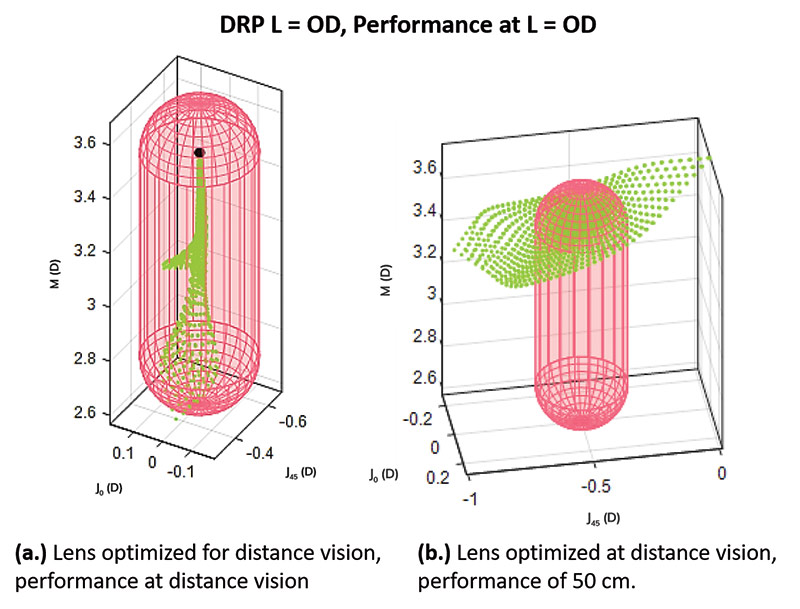Sponsored by IOT
By Deborah Kotob, ABOM
IOT has pioneered scientific advances and formulated alternative mathematical methods to overcome the limitations imposed by the geometry of free-form lens surfaces. With the breakthrough Digital Ray-Path® 2 Technology launch, they have formulated a new method of calculating the optimal lens surface to produce accurate power for all gaze directions and object distance ranges in the accommodative space.
Digital Ray-Path 2 lens surface calculations uniquely account for the wearer’s ability to use a small accommodative response to bring small oblique negative power errors into focus. Additionally, the mathematical method used to calculate the optimal free-form surface considers accommodative space rather than a single object space (focal distance) per gaze direction; thus, effectively expanding the area of unnoticeable blur (null blur regions - error < 0.18 D). As a result, oblique aberrations on the vertical axis are reduced to a small power error (minus power) that can be compensated by our eye’s natural accommodative response. Accommodative space is a volume in the object space in which points at various distances for a single gaze direction can be focused by the wearer’s accommodative facility. Small adjustments in accommodation compensate for small oblique negative power errors.
The eye focuses at different distances by employing accommodation. “Accommodation can be thought of as a natural adaptive optics mechanism to improve the retinal image quality of objects placed at different distances.” (ncbi.nlm.nih.gov/pmc/articles/PMC6911823) Accommodation describes the crystalline lens’ ability to increase its convex curvature to contribute more plus power, as needed, to bring objects into focus. Two main stimuli activate the accommodative response, retinal blur associated with the variation in the object distance and the change of convergence of the visual axes to achieve the correct binocular vision for a different fixation distance.

FIG. 1 A prescription of [+3.00+1.00×45 degrees], base curve 6 D and index 1.5, scatter plots for the lens used to view correctly optimized object
distance versus the view at an object distance for which the lens is not optimized
The computation of the oblique aberrations and the amount of blur for any gaze direction requires the selection of the object distance. To improve optical performance across a volume of space for an entire object distance range, Digital Ray-Path 2 optimizes the lens surface for more than one object distance per gaze direction. Let’s look at why this is important. With past technologies, the free-form lens surface optimization was for a single object distance per gaze direction, and the optical performance was nearly perfect for that single object distance/gaze combination.
However, the optical performance of this same lens rapidly declines when used to view an object at a distance different than the one for which it is optimized. Fig. 1 illustrates the optical performance decline in the scatter plot (b.) when viewing through a lens at an object distance different from the object distance the lens is optimized for (a.).

FIG. 2 The solid line represents the location of objects brought into focus with the estimated level of accommodation assumed by Digital Ray Path 2. The areas within the dash-dotted and dashed lines represent the furthest and closest boundaries of the accommodative space, reached with zero accommodation and maximum accommodation.
Digital Ray-Path 2 Technology ensures the lens performs optimally across an entire object distance range within a volume of accommodative space by bringing the oblique power error within the region of null (unnoticeable) blur for any object distance in the object space for a given gaze direction. For each gaze direction, there is a range of object distances accessible to the wearer, defined by their accommodative space and represented in Fig. 2. Digital Ray-Path 2 searches for the optimal free-form surface configurations for that entire range of vergence/distances.
Digital Ray-Path 2 is the new foundational technology for all IOT lenses going forward. This new core technology virtually eliminates full field blur for any gaze direction. Fig. 3 illustrates that 99.5 percent of the lens is fully optimized for any gaze direction, when the wearer accommodates slightly.

FIG. 3 DRP 2 manages to get the oblique powers for all gaze directions inside the region of unnoticeable blur, with a vertical stretch (mean power error) smaller than 0.75 D. With the new optimization, the amount of astigmatism is negligible across the entire surface.
“Lenses are math, not magic.” Tina Lahti, vice president of Sales and Marketing at IOT.













